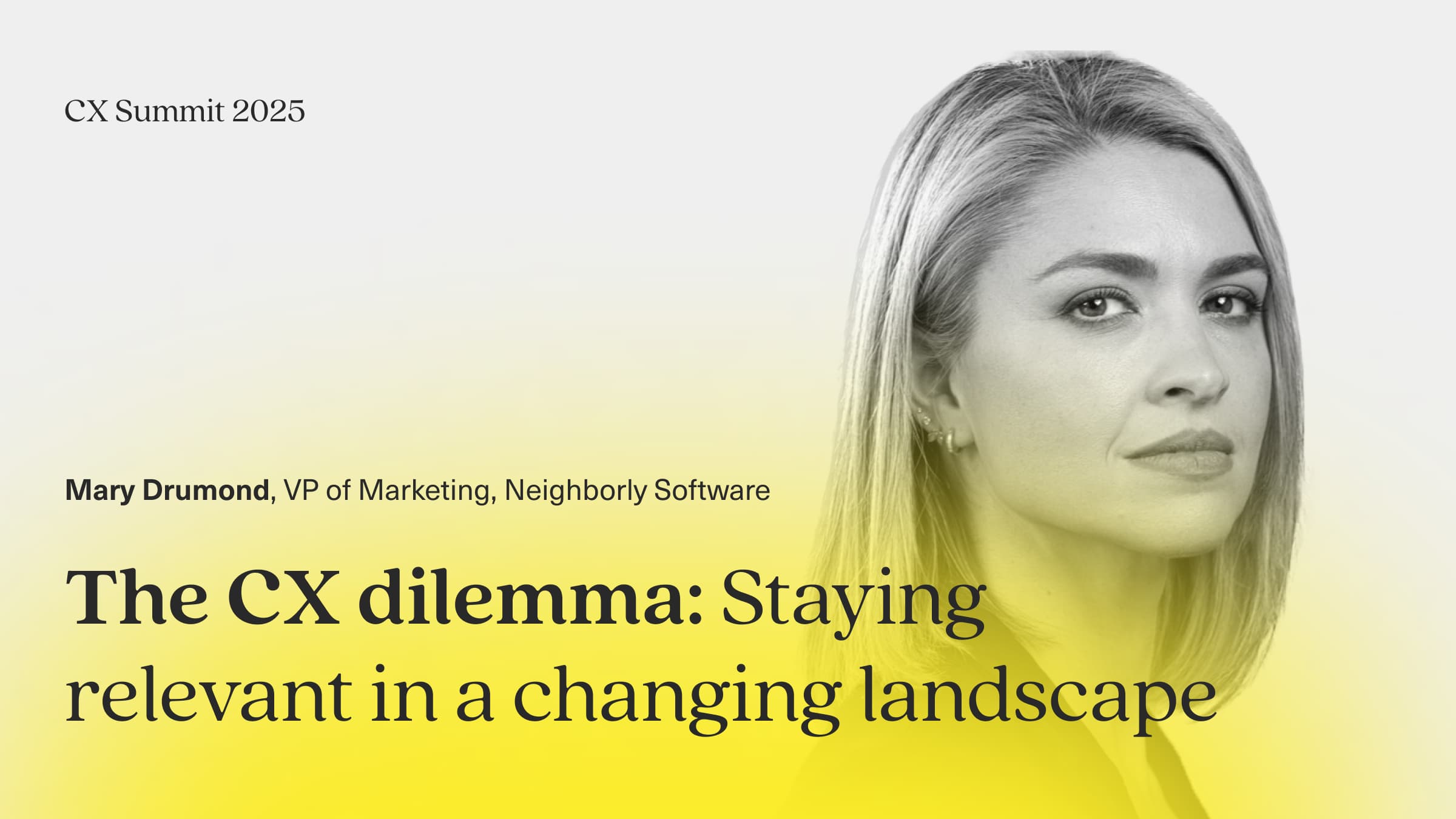Mary Drumond is the VP of Marketing at Neighborly Software and former host of the Voices of CX podcast. Gabe Larsen chatted with her during the CX Summit about staying relevant in the ever-changing landscape that is customer experience.
Let’s dig into Mary’s insights!
This interview has been edited for clarity.
Gabe Larsen: The landscape is clearly shifting, and it feels like CX hasn’t lived up to its promise. What’s your take on that?
Mary Drumond: I remember reading a 2016 Harvard Business Review article by Ryan Smith and Luke Williams from Qualtrics. They pointed out the same issues we’re still seeing: CX is failing because it wasn’t built with change in mind, the metrics are soft and not tied to business outcomes, and it moves too slowly without a clear purpose. That was almost a decade ago, and not much has changed. We did make progress convincing executives and boards that CX matters. But when they trusted us, we delivered fluff - packing peanuts.
Instead of becoming a revenue center, CX became a cost center, which put it in the crosshairs of every results-driven CFO.
Gabe Larsen: Exactly. Cut the investment and shift it somewhere with ROI.
Mary Drumond: Right, and while it’s unfortunate, it’s the reality we’re in right now.
Gabe Larsen: Yeah, some progress, but not the big transformational change we envisioned. You mentioned executives - why don’t they really get CX? And how can we shift that conversation? Is it about metrics?
Mary Drumond: It is, and it’s also about mindset. I lead marketing, and we constantly have to defend our work to the C-suite. But for CX, it’s even harder. Many CX professionals don’t think like executives. They aren’t prioritizing the organization’s top business goals.
A simple question: Do you know your company’s success metrics? Do you know what the leadership team is working toward? If your CX initiatives aren’t aligned with those outcomes, you’re setting yourself up to fail.
As an executive, if someone pitches me a program that requires time, money, or resources—but doesn’t support strategic goals—it’s a no-go. Everything needs to be tied to the CEO’s vision or to helping another leader hit their targets.
Gabe Larsen: That’s such a great point. CX can get lost in the weeds and lose sight of the bigger picture. And sometimes, like in marketing, the metrics just don’t translate. "We got this many impressions" doesn't mean much if it can’t be tied to revenue. So how do you think CX leaders should approach metrics?
Mary Drumond: Start by realizing that CX metrics like NPS or CSAT are just directional. They’re not success metrics. They’re thermometers. The metrics that matter are business outcomes: reducing churn, increasing retention, driving sales. That’s what executives care about.
Gabe Larsen: Totally. So many acronyms—CSAT, NPS—and they often miss the point.
Mary Drumond: Exactly. Those metrics are helpful internally, but if they don’t translate to financial impact like more revenue or reduced costs, they’re not going to resonate at the leadership level. You need to be able to show how customer satisfaction correlates with increased share of wallet or decreased churn.
Gabe Larsen: That connection is key. You’re talking to a lot of folks who are navigating these changes. What advice do you have for CX leaders trying to adapt or future-proof their roles?
Mary Drumond: I recently did a webinar with a few CX friends—Nate, Justin, Shep, and Juanita—and one takeaway was this: if you try to do everything, you’ll do nothing. CX is broad: UX, call centers, AI, chatbots, market research, journey mapping. Most companies can’t afford to staff a person for every piece. So if you’re not in a leadership role, become a specialist. Pick one area, get really good at it, and master that skill. If you’re in leadership, you need to be a generalist and know how to orchestrate multiple initiatives. But either way, you need to be strategic.
Also, don’t try to solve everything at once. Focus on solving one major problem, then use that success to get buy-in for the next. Evangelize internally. Show your impact and earn internal champions.
Gabe Larsen: I love that. Sometimes CX leaders focus so much on the external customer that they forget about the internal stakeholders. One more question before we wrap: AI. It’s obviously a big theme. You’ve seen it from different angles—go-to-market, CX, marketing. Any advice on how CX leaders should be thinking about AI?
Mary Drumond: Yes—use it when appropriate. AI is helping us serve customers faster and more efficiently, especially after-hours or when staffing is tight. But it can’t be the only solution. Too many companies are forcing customers into bad AI experiences with no alternative. If your customers aren’t comfortable with chat or AI, give them another channel. As AI improves, this will get better, but we’re not there yet. If the experience isn’t good enough, and customers have no other option, that’s when things go south.
Gabe Larsen: That’s such a good point. AI is powerful, but it’s not the silver bullet. You need to balance innovation with real customer impact.
Mary Drumond: Exactly. And some companies are cutting corners, launching immature AI solutions just to say they have them. That’s risky. My utility company has record profits—but their chatbot is terrible. If they’re doing that well financially, they could invest in better tech.
Gabe Larsen: That’s a perfect example. Alright, Mary, we covered a lot: the evolution of CX, aligning with the business, adapting with AI. What’s one final piece of advice you’d leave for the audience?
Mary Drumond: First, follow the money. That’s how you make your initiatives tangible to executives—by tying them to revenue growth or cost reduction. Second, solve one problem at a time. Don’t try to fix everything all at once. Third, build internal champions. Show your stakeholders how your work helps them succeed. Everyone is accountable to someone - if you can help your executive stakeholders hit their goals, they’ll support you.
And finally, be flexible. The market changes fast. Don't rely on the past to guide your future - stay proactive, predictive, and ready to shift.
Gabe Larsen: That’s so good. Sometimes we focus too much on the external customer, but internal alignment is just as important. Mary, thank you so much. We need you back in the CX world more often!
Closing thoughts
Mary’s key takeaways? CX hasn’t lived up to its potential due to weak metrics, lack of alignment with executive goals, and overreliance on technology like AI. Mary urges CX professionals to focus on business outcomes, solve one problem at a time, and build internal champions to gain traction. Her advice: be strategic, flexible, and always follow the money.
If you’re looking for a tool that can help you make big strides in your customer experience, check out Kustomer. Our all-in-one customer service platform and CRM, powered by AI, allows brands to streamline costs and operations.
Check out our guide on consolidating your CX tech stack or explore Kustomer today!




